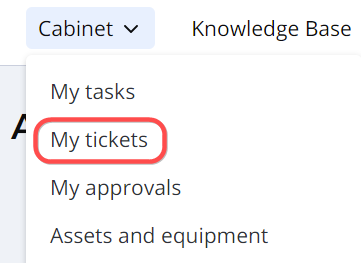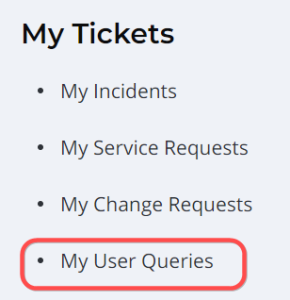You are viewing an old version of this page. View the current version.
Compare with Current View Page History
« Previous Version 36 Next »
A user query is one of the core components used in the communication between the end-user and the service desk department. User queries come to the fore when the end-user is unable to classify the type of their issue, whether it is an incident or a service request.
Create a user query
A user query can be created in three ways:
- via the Self-Service Portal (by end-user)
- via the agent interface (by agent)
- via email - inbound email actions (by end-user)
Via the Self-Service Portal
Role required: end-user.
To create a user query, complete these steps:
- Navigate to your Self-Service Portal and click Ask a question.
- Fill in the fields.
- Click Save.
User query form fields
The user query number has the INQXXXXXXX format and is populated automatically.
| Field | Mandatory | Description |
|---|---|---|
| Caller | Y | Specifies the originator of the user query. This field is populated automatically and is hidden on the Self-Service Portal form. |
| Contact Type | Y | Defines the source from which the request is received. This field populated automatically according to the origin of the source and is hidden on the Self-Service Portal form. Available options:
|
| Subject | Y | Type a brief description of the issue. |
| Description | N | Type a detailed description of the issue. |
| Urgency | Y | Specify the urgency of the issue. Typically, it is evaluated based on the time remaining until the issue impacts the business. For more information, see Priority Management. |
After the form is saved, a record is created in the User Queries (itsm_inquiries) table. At this time, the newly created user query is waiting to be processed by a service desk agent.
You can track the work process on the My Tickets page. To open the record of the user query, complete the following steps:
- In the header, navigate to Cabinet → My Tickets.

- Click My User Queries on the left.

- Check the state of the created user query.
Via the agent interface
To create a user query, complete these steps:
- Navigate to User Queries → All User Queries.
- Click New to add a record for a new user query and fill in the fields.
- Click Save or Save and Exit to apply the changes.
User query form fields
The user query number has the INQXXXXXXX format and is populated automatically.
| Field | Mandatory | Description |
|---|---|---|
| Caller | Y | Specify the originator of the user query. |
| Contact Type | Y | Define the source from which the request is received. Available options:
|
| Related Ticket | N | Specify the related configuration items affected by the user query. The user query is automatically connected to a related record and displayed on its form. |
| Subject | Y | Type a brief description of the issue. |
| Description | N | Type a detailed description of the issue. |
| State | N | This field displays the work state. Available states:
|
| Urgency | Y | Specify the urgency of the issue. Typically, it is evaluated based on the time remaining until the issue impacts the business. For more information, see Priority Management. |
User query states
A newly created user query is assigned the Unprocessed state. Once it is classified by a service desk agent, the state changes to Processed. Another possible state is Dropped, which is typically assigned to erroneous or spambot user queries.
Once a user query is created, it should be processed by ITSM agents. The processing of a user query involves its classification as one of the specific record types.
The following record types are available:
- Incident
- Problem
- Change Request
- Service Request
To classify a user query, an agent should complete these steps:
- Navigate to User Queries → Unprocessed.
- Open the required user query.
- Select the type by clicking the respective button in the top-right corner of the form.

Create other record types from user queries
In SimpleOne, a record of another type can be created from a user query after it is analyzed:
Create an incident from a user query
After a user query is analyzed, an incident can be created from it. For more information, see the Create Incidents article.
Create a problem from a user query
After a user query is analyzed, a problem can be created from it. To do so, complete these steps:
- Navigate to User Queries → Unprocessed.
- Open the required user query.
- Click Problem in the top-right corner of the form.
- Fill in the mandatory fields in the problem form:
- Click Save or Save and Exit to apply the changes.
As a result:
- The original user query state is changed to Processed.
- A new Problem record is created in the Registered state.
Create a change request from a user query
After a user query is analyzed, a change request can be created from it. To do so, complete these steps:
- Navigate to User Queries → Unprocessed.
- Open the required user query.
- Click Change Request in the top-right corner of the form.
- Select a previously created change template from the dictionary. This field is mandatory.
- Click Create to confirm the selection or Skip to cancel. In the second case, you will need to select the Change Type.
- Fill in the mandatory fields in the request form:
- Click Save or Save and Exit to apply the changes.
As a result:
- The original user query state is changed to Processed.
- A new Change Request record is created in the Registered state.
Create a service request from a user query
After a user query is analyzed, a service request can be created from it. To do so, complete these steps:
- Navigate to User Queries → Unprocessed.
- Open the required user query.
- Click Service Request in the top-right corner of the form.
- Select a previously created request template from the dictionary.
- Leave the field empty if this request is classified as non-typical.
- Click Create.
- Fill in the mandatory fields in the request form:
- Click Save or Save and Exit to apply the changes.
As a result:
- The original user query state is changed to Processed.
- A new Service Request record is created in the Registered state.
- No labels